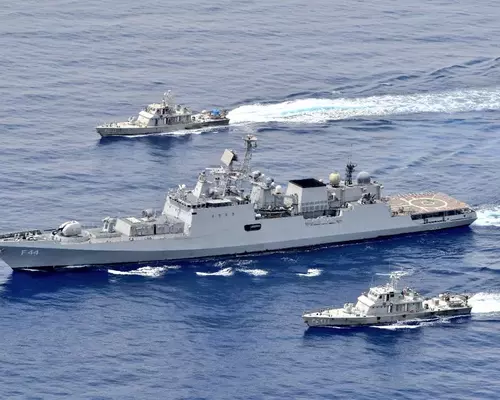

Maiden Maritime Partnership Exercise between Indian Navy and Sudanese Navy in the Red Sea.
<p>
On September 10, the Indian navy<a href="https://indiannavy.nic.in/content/ins-tabar-conducts-maritime-partnership-exercise-sudanese-navy"> carried</a> out a maritime partnership exercise with the Sudanese navy in the Red Sea. Despite building a strong energy partnership in the 2000s, it was the first time that Indian and Sudanese navies conducted such an exercise. From the Indian side, INS Tabar participated in the exercise along with the Sudanese ships Almazz and Nimar.</p>
<p>
The exercise included &lsquo;multiple activities covering a wide range of naval operations&rsquo; such as &lsquo;co-ordinated manoeuvring, replenishment at sea [RAS] drills, helo operations, operations for interdicting suspect vessels at sea and communication procedures.&rsquo; The exercise &lsquo;enhanced interoperability between the two navies significantly and widened the scope for combined operations against common maritime threats in future.&rsquo;&nbsp;</p>
<p>
INS Tabar is on an overseas deployment to Europe and Africa. Apart from Sudan, it has also <a href="https://indiannavy.nic.in/content/ins-tabar-conducts-maritime-partnership-exercise-egyptian-navy">conducted</a> naval exercises with the Egyptian navy in the Mediterranean. Egypt and Sudan are important players in the geopolitics of the Red Sea and due to their proximity with the Suez Canal, are located along one of the most important maritime routes. Therefore, both of these exercises are of significant strategic import and point towards the expanding maritime horizons of the Indian navy.</p>
<p>
<strong>Red Sea Geopolitics</strong></p>
<p>
The Red Sea links West Asia with Africa and is a critical geopolitical space where the rivalries between the Gulf powers are being played out. The <a href="https://www.theafricareport.com/50046/the-red-sea-a-vital-artery-for-the-world-economy/">Red Sea</a> also links the Indian Ocean to the Mediterranean through the strait of Bab-el-Mandeb and Suez Canal. Large quantities of oil and trade pass through the Red Sea. It is a critical waterway for global energy security and the international economy. The recent<a href="https://www.bbc.com/news/business-56559073"> blockage</a> of the Suez Canal underscored the strategically important role of the Red Sea and Suez Canal for the global economy.</p>
<p>
<strong>Also read:</strong>&nbsp;&nbsp;<a href="https://www.indianarrative.com/opinion-news/why-has-uae-dared-to-establish-a-strategic-foothold-at-socotra-107688.html">Why has UAE dared to establish a strategic foothold at Socotra?</a></p>
<p>
In the last few years, the Red Sea has emerged as a critical sub-theatre in the evolving geopolitics of the Western Indian Ocean (WIO). Foreign powers have<a href="https://www.usip.org/publications/2018/12/red-sea-region-competing-outside-powers-complicate-us-interests"> established</a> their military presence in the region and are taking a greater interest in the affairs of the maritime as well as continental space in and around the Red Sea. Russia, China, the United States (US), France, and Japan hold military facilities in the region. Even the United Arab Emirates (UAE) and Saudi Arabia are active in shaping the trajectory of regional geopolitics and security.&nbsp;</p>
<p>
In fact, the presence of <a href="https://www.icwa.in/WriteReadData/RTF1984/5898247569.pdf">security threats</a> such as terrorism and maritime piracy brought foreign powers to the region. US established its expansive network of bases in the WIO and Africa including at Djibouti after launching the Global War on Terror. Maritime <a href="https://www.reuters.com/article/idUSL3623177">piracy</a> in the Gulf of Aden around 2007-08 was threatening global shipping and Somalia was unable to contain pirates operating out of its territorial waters. Therefore, a multinational maritime security effort was launched. The navies of major powers including Russia, China, Japan, and South Korea sent their warships to the region to participate in the anti-piracy operations.</p>
<p>
<strong>Indian Naval Presence</strong></p>
<p>
The Indian navy too played a key role in the counter-piracy operations. India is a resident naval power with a willingness and desire to contribute towards the maintenance of regional security in the Indian Ocean including in the sub-theater of the Northwest Indian Ocean. Over the years, India has managed to regularize its maritime presence in the Gulf of Aden and Southwest Indian Ocean. Time and again, India has<a href="https://www.deccanherald.com/opinion/understanding-indian-ties-with-horn-of-africa-countries-908243.html"> extended</a> much-needed humanitarian assistance to the littoral states in the region. India has also positioned itself as the &lsquo;preferred security partner&rsquo; in the region.</p>
<p>
<strong>Also read:&nbsp;</strong>&nbsp;<a href="https://www.indianarrative.com/opinion-news/from-kenya-to-guam-india-outlines-sphere-of-interest-in-the-indo-pacific-with-string-of-naval-exercises-106970.html">From Kenya to Guam, India outlines sphere of interest in the Indo-Pacific with string of naval exercises</a></p>
<p>
Indian navy is uniquely placed in the regional geopolitics of the Northwest Indian Ocean. It enjoys close relationship with the US, Japan, and France, and consequently, the Indian navy ships can <a href="https://www.moneycontrol.com/news/opinion/foreign-affairs-why-indias-medical-assistance-to-djibouti-matters-6882971.html">access</a> their naval bases in Djibouti. Russia&rsquo;s upcoming naval base at Port Sudan also opens up opportunities for greater collaboration between Indian and Russian navies in the Red Sea and WIO.</p>
<p>
India&rsquo;s deepening strategic partnership with UAE could be strengthened further in the domain of maritime security in the context of the geopolitics of the Red Sea and the Gulf of Aden. India and Taiwan share an interest in containing Chinese power. The Taiwanese<a href="https://thediplomat.com/2021/09/the-somaliland-connection-taiwans-return-to-africa/"> presence </a>in Somaliland and UAE&rsquo;s facilities along the Red Sea and the Gulf of Aden including<a href="https://www.indianarrative.com/economy-news/reviving-the-port-of-berbera-why-india-and-the-uae-can-become-partners-in-the-western-indian-ocean-105500.html"> Berbera </a>could be leveraged for keeping a close watch on the Chinese activities in the region.</p>
<p>
The entire region lying between the Suez Canal and Japan is seeing an <a href="https://www.deccanherald.com/opinion/new-delhis-maritime-security-pivot-1026885.html">expanding</a> Indian maritime footprint. The growing interest in the region is demonstrated by regularly deploying warships for conducting naval exercises with friendly countries and for carrying out defence diplomacy. As a result, the Indian navy is indicating that Western Pacific and the Red Sea are emerging as integral parts of its strategic dynamics. The naval exercises with Egyptian and Sudanese navies demonstrate the expanding strategic maritime horizons and underscore the growing salience of the Red Sea in India&rsquo;s security matrix.&nbsp;</p>
<p>
<strong>(Sankalp Gurjar is a Research Fellow with the Indian Council of World Affairs, New Delhi. Views are personal.)</strong></p>
Union Minister Ashwini Vaishnaw said many Russian companies are considering India as a base for…
US President Donald Trump has claimed that "monumental damage" was inflicted upon nuclear sites in…
Amid Iran's plan to close the Strait of Hormuz, one of the most strategically vital…
Israel's Permanent Representative to the United Nations, Danny Danon, hailed the recent US strikes on…
Russia's Ambassador to the United Nations, Vassily Nebenzia, sharply criticised the United States for its…
Iran's Ambassador to the United Nations, Amir Saeid Iravani, on Sunday accused Israel of sabotaging…